Men armed with crude weapons on the outskirts of Ramaphosa in 2008, shortly before they gave chase to several men who appeared to evade the attack by hiding in nearby mine dumps. (James Oatway)
Xenophobic, or more precisely, Afrophobic violence in South Africa is often portrayed as happening within a sealed-off bubble of black life. Subject to its potrayal within the flow of news cycles, the prevailing images and accompanying storylines are often limited in context, with the emerging narratives often hinged on a framing device too similar to the black-on-black ruse offered up by the apartheid regime to hide its orchestration of a bloody transition to democracy.
With legislated apartheid now gone, the violence of its afterlife, represented in this case particularly by Afrophobia, is often portrayed as cyclical or spontaneous as opposed to emerging from a wider, more fixed paradigm intrinsic to the follies of racial hierarchies and nation statehood.
Alon Skuy and James Oatway’s BR[OTHER] is a book of photographs taken mainly from the frontlines of the violence, augmented with essays that try to bring complexity to the sometimes chilling images. It attempts to work away from the strictures, particularly when the images are read with the essays that thread them together.
Some attempt has been made by the photographers to present an arc that stretches the story beyond the township streets and inner-city slums as killing fields. Perhaps, this is recognition that, for the most part, black people, be they from within these borders or beyond, coexist in a tacitly understood, precarious pact formed out of the collective wretchedness of their daily lives. The title of the book hints at this.
My conversation with the photographers, shortened here because of space constraints, ranged over the limits of photojournalism in bringing to the fore sufficiently complex narratives around xenophobia. In my case the difficulty in confronting these images is not so much shame, as Justice Edwin Cameron suggests in one of the essays, as much as misgivings in how far they go in shattering the myth of black belonging in South Africa.
If we are to think of what citizenship actually means, what protections it offers or, in the South African case, promises those it considers as a part of its fold, then we should understand the perpetrators of xenophobic violence as playing a fool’s game, killing for the materialisation of a dream in which they will never have a stake.
Just as the “Xhosas” and “Zulus” who slaughtered each other in the so-called hostel wars, or however we’d like to frame the lead-up to 1994, what I see in these images is people in service of agendas executed and kept in place long before they were born. Often there is not much emphasis placed on the gulf between their actions and those of the state that reactively intensifies the choke of draconianism on the other, only to dangle its outcomes as a carrot to the lowliest of its “citizens”.
The state the perpetrators call to in ritualised acts of bloodletting is one that was never set up to answer their call. If we understand nationalistic borders to be as superficial as Bantustan boundaries were, and yet, irreversible, then we need to look beyond the immediate protagonists when seeking to understand the workings of xenophobia. For me the unanswered questions become: Who do these orchestrated killings benefit, ultimately? And by extension: What need do these images serve?
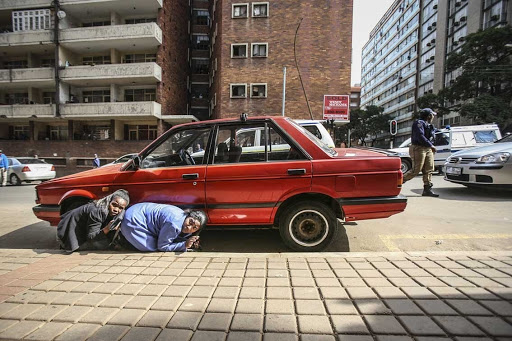 Pedestrians duck for cover as police attempt to control unrest in the Johannesburg inner city. (Alon Skuy)
Pedestrians duck for cover as police attempt to control unrest in the Johannesburg inner city. (Alon Skuy)
You say you share common values when it comes to photography. What values guide this project?
Alon Skuy: As far as news coverage, I would say it is trying to portray events as close to what happened as possible. We like to get various sides of the story. We try to portray the story as truthfully as possible.
James Oatway: We’re not interested in exploiting the people we photograph. We share a bit of a sensitivity as to who we are and where we come from. We are both white males. We are both acutely aware of the white male gaze and the colonial gaze, and we are not interested in trying to reinforce racist tropes and things like that. We do try and have some empathy with our photography.
 A crowd gathers in Alexandra before raiding nearby government-subsidised houses, demanding to see ID documents and beating non-South African residents. (James Oatway)
A crowd gathers in Alexandra before raiding nearby government-subsidised houses, demanding to see ID documents and beating non-South African residents. (James Oatway)
With this subject matter it becomes very difficult to work away from that. Capturing acts of violence says or doesn’t say things about the people who perpetrate it. It can dehumanise the people against whom violence is perpetrated, and the perpetrators as well, because they are also subjected to violence. How difficult is that in the heat of the moment, when you are capturing something gruesome but also want to be aware of what the images can say or fall short of saying?
JO: In the heat of the moment when there is violence unfolding, you don’t have that much time to frame things in a certain way. It is these acts that are dehumanising. You are reacting and photographing stuff. You don’t have time to think about what you are photographing. Where the humanising and dehumanising come into play is how those pictures are used, where they are used; the context of the use. With this book, we’ve been conscious about how violence can dehumanise both the perpetrators and the victims. That’s why it was important to situate these photographs among other pieces of writing that add context and represent different voices, and to balance them with photographs that don’t show people in distress, but in their own environments. We gave very careful thought to how we laid out the book and the balance of photographs. We don’t want to shy away from the violent images because it really happened and this is what we saw and it’s disgusting, but it is what we see and what we recorded.
The [Emmanuel] Sithole images [a Mozambican informal trader who was photographed by Oatway in 2015 as he was stabbed to death] were used in the Sunday Times the day after I took them. There was a massive reaction. People criticised me personally for not having intervened. A lot of people spoke out against xenophobic violence. There were demonstrations. The government sent the army there the following day. It was right to show people, “This happened yesterday on your doorstep, do you know that this is happening?” But when they were used again and again in opinion pieces that didn’t sit well with me. I thought it was trivialising, even exploitative. When we had the exhibition a few years ago, the exhibition that led to the book, I was quite happy to put that picture down in a book in a more sensitive way, that treats the people in the photograph in a more respectful way. To have the bigger picture there.
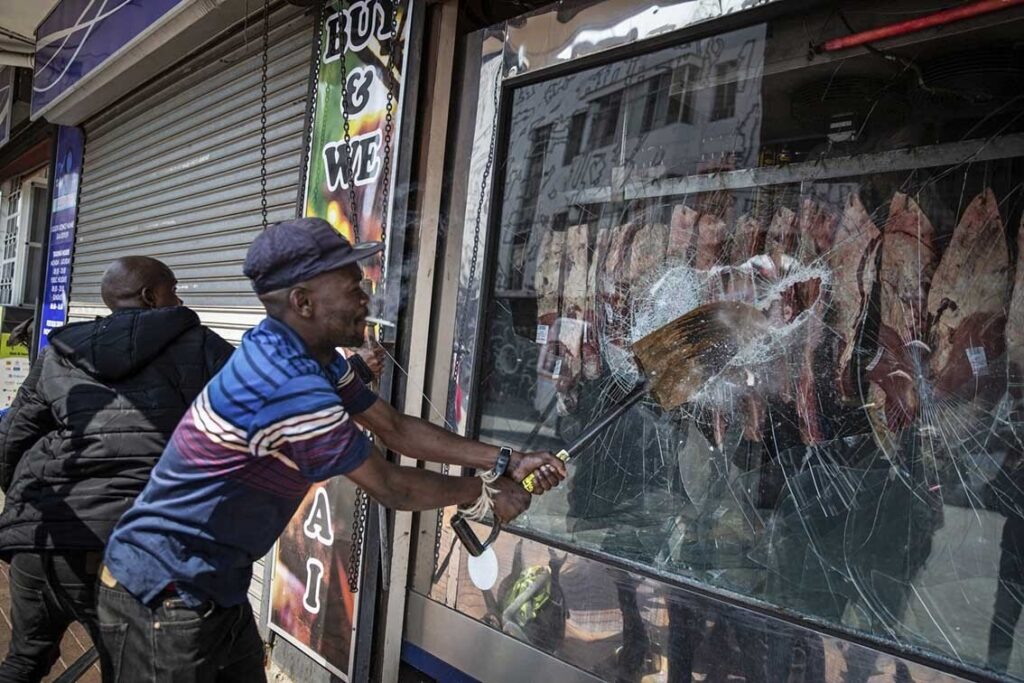 As angry bands of smash-and-grabbers run amok through the inner city streets, a man lays waste to a butchery before the meat is looted in 2019. (James Oatway)
As angry bands of smash-and-grabbers run amok through the inner city streets, a man lays waste to a butchery before the meat is looted in 2019. (James Oatway)
How did you deal with the criticism of “letting the event unfold”?
JO: What people didn’t know was that the entire attack lasted 27 seconds. People think it took 15 or 20 minutes and I might have had time to make phone calls and flag someone down or something like that. From the first picture to the last one, it was 27 seconds, you don’t have much time to do anything. When the attackers did notice me, they stopped, although it was too late. The fatal wounds had been inflicted. The main criticism was that I didn’t intervene and the other was that I was exploiting black pain for commercial benefits. Others weren’t directed at me, personally. They were talking about xenophobia and criticising the government. Some of the Twitter stuff was quite nasty, with people saying, “I hope you get murdered in the street while somebody photographs you.”
I knew that this photograph was so terrible that I expected it to upset people. It’s good that it upset people. You can’t see those images and not be affected in some way.
What has been the emotional toll of that day on you?
JO: In some ways I felt a responsibility to be involved with everything to do with xenophobia after that. I took everything personally. Whenever there were attacks I felt like I should personally go there or it would be a dereliction of duty.
There was a lot of regret that Emmanuel Sithole died. We took him to a clinic and we wasted a lot of time there in that clinic. You start thinking: “What if I’d done this or done that? What if I’d held that wound closed for longer? Or if we’d gone straight to the hospital?”
I remember going to work with his blood all over my clothes. I got into the office and filed the pictures and went home feeling physically sick. In the years that have passed that hasn’t lessened. The issue of xenophobia hasn’t become less important to me because I see it increasing all the time. You see people on Twitter referring to migrants as cockroaches and dehumanising things like that. That makes me angry.
This book was important in that I had more control over these images and how they were used; the size, the context and that kind of thing, which I didn’t have [before]. When they first came out, they were used on the front page. To me to have photographed those pictures and for them to have been used inside, that would have been a painful moment. It would have meant that all of that would have happened for nothing. But their subsequent use has been used to misrepresent other events.
This has stayed with me. I’ve tried since then to photograph migrant issues differently; not only to photograph violence but to photograph other issues that can humanise migrants.
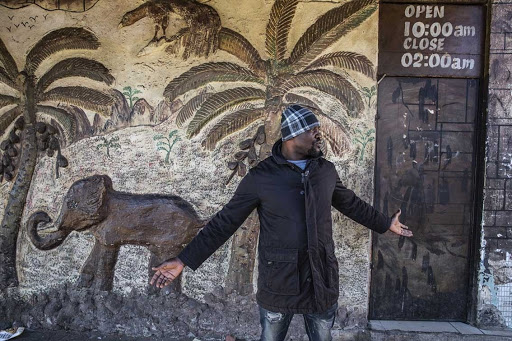 A man stands outside a looted bar in Malvern after a night of heavy destruction in the area in 2019. (Alon Skuy) .
A man stands outside a looted bar in Malvern after a night of heavy destruction in the area in 2019. (Alon Skuy) .The perpetrators of xenophobic violence themselves often feel a sense of being outsiders. Many are labour migrants, living in worsening conditions in the hostels. There is that photograph of hostel dwellers lying on top of each other piled up in a corner, looking like the dead themselves. How have you come to think of this notion of the outsider, the foreigner, the person who doesn’t belong and these contestations of citizenship, especially along that frontier of Jeppestown and how the violence unfolds there? What do you think sustains these battles for citizenship?
AS: I think there are similarities between the two. South African migrants have their own issues to contend with, service delivery problems, being outsiders themselves who feel disenfranchised. Those Jeppe raids show that South Africans themselves are victims in these cycles of xenophobic violence. Even though the hostels are where the rhetoric often comes, there is that element of the other in itself. That has to be recognised and addressed, but violence is never an acceptable reaction to these feelings. Sent out to cover this violence, you see poor South African communities who suffer post-traumatic stress disorder from having witnessed these attacks. There are victims on both sides.
I want to turn to some of the essays in the book. Achille Mbembe’s essay is emotive and complex. Initially, I felt that it bordered on framing the violence as purely black-on-black, which evokes the myopic language of the early nineties, but on several more readings, it seems to place a virtuous expectation on the nation state. But it led me to think about the larger framework that makes this violence possible, because at various levels, you are dealing with the limits of agency, stretching up to the highest echelons of the state.
JO: I think it’s an interesting reading of Mbembe’s essay. It’s a good one. And we included that essay precisely because it reflects a different perspective. Obviously, it’s not our viewpoint, but we included that there and tried to have a couple of different voices. We want people to talk about things like this.
I would say that there are people who try to manipulate xenophobic violence and instigate it for their own personal reasons, and that these are changing all the time.
We’ve picked up on several types of xenophobic violence, even. Some of the stuff you see in Soweto, for example, where migrant-owned shops will be looted but hardly anyone would be harmed, people would be chased away and there might be small injuries, but there isn’t a death toll. That [ghastly] level of violence isn’t really there. That, I believe, comes from local businesses reacting by putting out rumours that Somalians are selling stuff that is past its sell-by date. They whip up crowds, whip up emotions and encourage people to loot shops. There is a commercial [dynamic at play] there.
We’ve seen in other places, like in Pretoria, migrants have been referred to as drug dealers, [as if to imply that] all migrants are drug dealers now, and that’s a way to get rid of them or get them out of the townships.
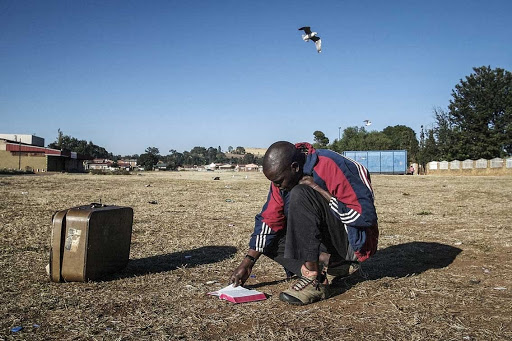 A refugee reads his bible at a temporary shelter in a field outside a police station on the East Rand. Shelters were erected after migrants requested repatriation to their home countries. (James Oatway)
A refugee reads his bible at a temporary shelter in a field outside a police station on the East Rand. Shelters were erected after migrants requested repatriation to their home countries. (James Oatway)
At the moment, dodgy parties and politicians are using dehumanising rhetoric. To me those two things are definitely related. If there was a third force, and I don’t know if I agree with that term, it’s constantly changing. It’s people in positions of power and leadership, or people aspiring to power using migrants as scapegoats.
Justice [Malala] talks about how King Goodwill Zwelithini, who recently died, instigated some of the 2016 violence with some comments he made. Whether that’s true or not remains to be seen. A human rights commission cleared him. But these are the types of things happening, and it’s on the increase because they are easy targets really.
AS: Xenophobic violence is a problem here, it is a problem in Europe, where Auschwitz in Nazi Germany was the biggest mass killing site in history, or the Rwandan genocide … Right now, there is a xenophobic attitude towards Asians. It is part of a world problem.
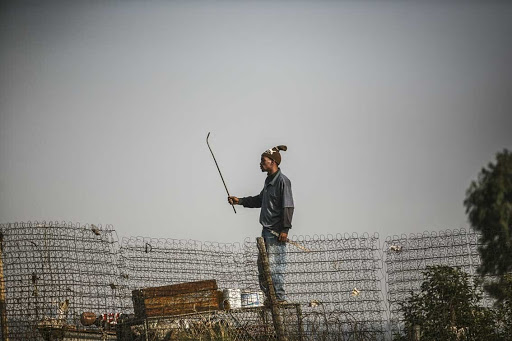 A shack roof becomes a vantage point at the height of anti-migrant sentiment in various areas around Ramaphosa, Johannesburg, 2008. (Alon Skuy)
A shack roof becomes a vantage point at the height of anti-migrant sentiment in various areas around Ramaphosa, Johannesburg, 2008. (Alon Skuy)The reason I bring up Mbembe’s essay is because he is a fine scholar of the post colony and it’s clearly the processes of history that bring us to our present moment. Don’t you think that the reasons we are here, in terms of the nature of this violence and the nature of our society is because of a direct line traceable to colonialism and how that shaped borders and ideas of citizenship? It shapes who gets to participate in the civic life of a country and who doesn’t. Is it not reasonable to see xenophobic violence as flowing from those processes?
JO: Definitely you can trace the origins to colonialism. The borders of Africa were drawn up by white men in Europe in the 1800s and before when it was a European playground. Some of those borders were randomly drawn up on maps, going through villages, separating families and ethnic groups. In South Africa in particular, there is everything we come from, apartheid and all of that. Our history is from that. So we have to see it as part of a reaction.
I want to stress that Alon and I are not experts in history and sociology, but what we see is the frontline of how these things unfold. The academic experts often don’t get to see that. That is the reason I think this book is important, because those are the kinds of questions we want people to discuss and take further. We could have many arguments about why we should not have as many migrants as we have in South Africa, but you’ll never convince me of an argument that justifies violence to someone, to kill someone in such a brutal manner because they are from somewhere else.
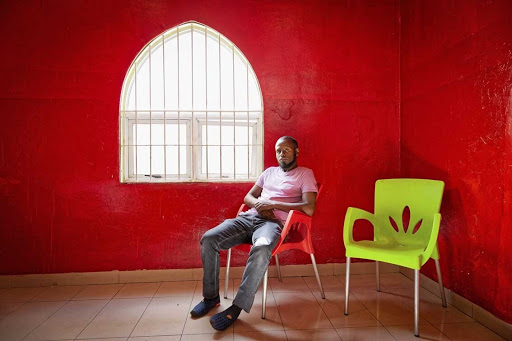 Johannesburg-based restaurateur Adnaan Yassin Abdullahi fled Ethiopia and arrived in South Africa in 2008 as xenophobic violence swept the country. (James Oatway)
Johannesburg-based restaurateur Adnaan Yassin Abdullahi fled Ethiopia and arrived in South Africa in 2008 as xenophobic violence swept the country. (James Oatway)I think that recognising the origins of violence makes it possible to find other ways of thinking about it; even about how to even portray it photographically.
JO: I hope people can build on what’s in this book and try to use it as a learning tool to figure out how we can stop it. The levels of brutality are shocking. This level of violence is really extreme, it’s angry. It’s possible that that comes from the violent history that South Africa has experienced over the years.
But since 2008 there hasn’t been any real action taken to get to the bottom of this, and that’s one of the reasons we became motivated to take this further. Because we became sick and tired of hearing: “Oh, there’s been another xenophobic violence episode.”
The government doesn’t really acknowledge it. There are no educational programmes, even at schools. People need to try and find answers to those questions.
Our book confronts the unpopular issue of xenophobic violence directly. This is an issue that everyone knows about but no-one likes to talk about. The images document the brutal fallout and the human beings involved. They are difficult to view but they are at the heart of the issue and can’t be ignored.
Throughout history photography has been a way to expose the atrocities that people commit against each other. In South Africa, photography exposed the injustices of the Sharpeville massacre, the 1976 Soweto uprisings and Marikana in ways that other mediums haven’t quite been able to.
There are many complex reasons why the violence happens. We hope that readers take it upon themselves to interrogate the work, and the reasons, and are ultimately moved to think differently about xenophobia.
[BR]OTHER by James Oatway & Alon Skuy is published by Jacana Media.